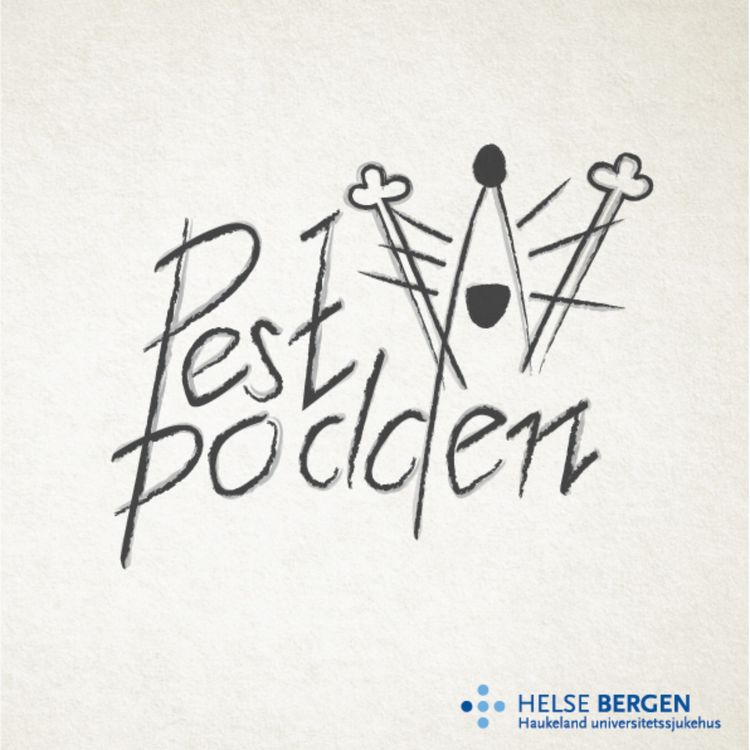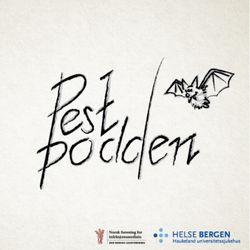Share

Pestpodden
Pilotepisode, del 2: Syfilis – sjanker og serologi
Ingrid har alltid slitt med å forstå syfilisdiagnostikken, men i løpet av tiden på mikrobiologen har det gått opp et lys! Ingrid og Jørgen guider dere (og seg selv) gjennom serologiens jungel.
Referanser:
1. Sandvik A, Kveim Lie A. Ubehandlet syfilis - fra Oslo til Tuskegee. Tidsskr Nor Legeforen 2016 136: 2010-6
2. Tampa M, Sarbu I, Matei C, Benea V, Georgescu SR. Brief history of syphilis. J Med Life. 2014;7(1):4-10.
3. Vesterhus P. Hvordan ble Osvald syk? Tidsskr Nor Lægeforen 2007 127: 1814-6
5. Gordon AG. Diagnosis of Oscar Wilde. Lancet. 2001;357(9263):1209.
6. Tobin MJ. Fiftieth Anniversary of Uncovering the Tuskegee Syphilis Study: The Story and Timeless Lessons. Am J Respir Crit Care Med. 2022;205(10):1145-58.
7. Ropper AH. Neurosyphilis. N Engl J Med. 2019;381(14):1358-63.
8. Gjestland T. The Oslo study of untreated syphilis; an epidemiologic investigation of the natural course of the syphilitic infection based upon a re-study of the Boeck-Bruusgaard material. Acta Derm Venereol Suppl (Stockh).1955;35(Suppl 34):3-368
9. Dhakal A, Sbar E. Jarisch Herxheimer Reaction. [Updated 2022 Apr 28]. In: StatPearls [Internet]. Treasure Island (FL): StatPearls Publishing; 2023 Jan-.
10. CDC. Sexually Transmitted Infections Treatment Guidelines. July 2021
11. FHI. Syfilis - veileder for helsepersonell. Smittevernveilederen. Oppdatert 07.04.2019.
12. OUS metodebok, HUS metodebok.
13. Intervju avdelingsoverlege Turid Thune (muntlig meddelelse).
More episodes
View all episodes

28. NCSMID 2025 - en liten reportasje
27:00||Season 1, Ep. 28Jørgen og Ingrid har vært på ekspedisjon til NSCMID 2025 - og sydd sammen et sammendrag fra denne årlige, nordiske konferansen. Gjør deg klar for litt av høstens infeksjonsmedisinske nyheter - og litt hobbyentymologiske betrakninger rundt mygg kommer gratis med på kjøpet!
Fungus amoung us - a dive into medical mycology - with Neil Stone
39:25||Season 1In today`s episode we speaking with Neil Stone, consultant in ID and microbiology, lead for mycology at University College Hospital London/Hospital for Tropical Diseases associate professor at University College London. We give you a "broad-spectrum"-dive into the fungus-field, including the latest news on Candida auris, strange names of new drugs and the other mysteries of mycology.
28. Sopp! - med Klaus Høiland
36:20||Season 1, Ep. 28Høsten er her og det samme er soppen! Vi har intervjuet mykolog, biolog og professor Klaus Høiland om alle soppens fortreffeligheter - fra tidenes morgen til i dag. Bli med på en fun(gus)fact-spekket episode!
27. Meslinger - den lille sykdom?
32:16||Season 1, Ep. 27Meslinger har vært en fryktet og hyppig forekommende sykdom opp gjennom historien. I moderne tid og med effektiv vaksine falt forekomsten – men i senere år har man sett stadig flere tilfeller (og utbrudd), inkludert i Europa og USA. Ingrid, Jørgen og Nikolai snakker seg gjennom meslinger «fra tidenes morgen» og frem til i dag. Bli med på reisen!Og - for infeksjonsmedisinsk helsepersonell som lytter til episoden våren 2025 - her er lenke til påmelding NSCMID: Home - NSCMID 2025.Referanser:1. Roald Dahl, 1986: “Measles: A dangerous disease” (open letter to parents).2. Hübschen JM, et al. Measles. Lancet. 2022;399(10325):678-90.3. Berche P. History of measles. Presse Med. 2022;51(3):104149.4. Petrova VN, et al. Incomplete genetic reconstitution of B cell pools contributes to prolonged immunosuppression after measles. Sci Immunol. 2019;4(41).5. Mina MJ, et al. Measles virus infection diminishes preexisting antibodies that offer protection from other pathogens. Science. 2019;366(6465):599-606.6. Belongia EA, Naleway AL. Smallpox vaccine: the good, the bad, and the ugly. Clin Med Res. 2003;1(2):87-92.8. Madsen KM, et al. A population-based study of measles, mumps, and rubella vaccination and autism. N Engl J Med. 2002;347(19):1477-82.10.Holzmann H, et al. Eradication of measles: remaining challenges. Med Microbiol Immunol. 2016;205(3):201-8.11.Jafri SK, et al. Subacute sclerosing panencephalitis - current perspectives. Pediatric Health Med Ther. 2018;9:67-71.12. de Swart RL, et al. Rinderpest eradication: lessons for measles eradication? Curr Opin Virol. 2012;2(3):330-4.13.Kim TH, et al. Vaccine herd effect. Scand J Infect Dis. 2011;43(9):683-9.14.Doll MK, Correira JW. Revisiting the 2014-15 Disneyland measles outbreak and its influence on pediatric vaccinations. Hum Vaccin Immunother. 2021;17(11):4210-5.13.Nuwarda RF, et al. Vaccine Hesitancy: Contemporary Issues and Historical Background. Vaccines (Basel). 2022;10(10).16.Minta AA, Ferrari M, Antoni S, et al. Progress Toward Measles Elimination — Worldwide, 2000–2023. MMWR Morb Mortal Wkly Rep 2024;73:1036–1042.17.State School Immunization Requirements and Vaccine Exemption Laws, CDC 2022,State School Immunization Requirements and Vaccine Exemption Laws18.Epidemiologi meslinger UK og Europa: https://www.gov.uk/government/publications/measles-epidemiology-2023, European Region reports highest number of measles cases in more than 25 years – UNICEF, WHO/Europe
26. Tyfus, Napoleon og Emil i Lønneberget
30:12||Season 1, Ep. 26Tyfus har satt sitt preg på både litteratur og historie - og Europakartet kunne kanskje sett annerledes ut var det ikke for denne vektorbårne bakterien.Jørgen, Nikolai og Ingrid drar på reise igjen, denne gang for å finne ut av mer om tyfus om dens slektninger, rickettsiosene.Referanser:1) Pesapane F et al. Hieronymi Fracastorii: the Italian scientist who described the "French disease". An Bras Dermatol. 2015 Sep-Oct;90(5):684-6. doi: 10.1590/abd1806-4841.20154262. PMID: 26560214; PMCID: PMC4631234.2) Peterson, R. K. D. 1995. Insects,disease, and military history: the Napoleonic campaigns and historical perception. American Entomologist. 41:147-160. 3) Angelakis E et al. The History of Epidemic Typhus. Microbiol Spectr. 2016 Aug;4(4). doi: 10.1128/microbiolspec.PoH-0010-2015. PMID: 27726780.4) Larry Lutwick. Brill-Zinsser disease. The Lancet, Volume 357, Issue 9263, 2001, Pages 1198-1200, ISSN 0140-6736, https://doi.org/10.1016/S0140-6736(00)04339-7.(https://www.sciencedirect.com/science/article/pii/S0140673600043397)5) Weiss E, Strauss BS. The life and career of Howard Taylor Ricketts. Rev Infect Dis. 1991 Nov-Dec;13(6):1241-2. doi: 10.1093/clinids/13.6.1241. PMID: 1775858.6) Walker DH. Ricketts creates rickettsiology, the study of vector-borne obligately intracellular bacteria. J Infect Dis. 2004 Mar 1;189(5):938-55. doi: 10.1086/381710. PMID: 14976612. Ricketts Creates 7) Jan Brøgger sr. Epidemier. En natur-og kulturhistorie. Damm forlag. 2020.8) Emelyanov VV. Evolutionary relationship of Rickettsiae and mitochondria. FEBS Lett. 2001 Jul 13;501(1):11-8. doi: 10.1016/s0014-5793(01)02618-7. PMID: 11457448.9) Mørch K et al. Acute undifferentiated fever in India: a multicentre study of aetiology and diagnostic accuracy. BMC Infect Dis. 2017 Oct 4;17(1):665. doi: 10.1186/s12879-017-2764-3. PMID: 28978319; PMCID: PMC5628453.10) Raoult D et al. Outbreak of epidemic typhus associated with trench fever in Burundi. Lancet. 1998 Aug 1;352(9125):353-8. doi: 10.1016/s0140-6736(97)12433-3. PMID: 9717922.11) Didier Raoult et al. Evidence for Louse-Transmitted Diseases in Soldiers of Napoleon’s Grand Army in Vilnius, The Journal of Infectious Diseases, Volume 193, Issue 1, 1 January 2006, Pages 112–120.12) Varghese GM et al. INTREST Trial Investigators. Intravenous Doxycycline, Azithromycin, or Both for Severe Scrub Typhus. N Engl J Med. 2023 Mar 2;388(9):792-803. doi: 10.1056/NEJMoa2208449. PMID: 36856615; PMCID: PMC7614458.
25. Flaggermusens mysterier
47:23||Season 1, Ep. 25VI har dykket ned i flaggermusens underlige verden. Hvordan kan det ha seg at flaggermusen er bærer av (og tilsynelatende lever uaffisert med) en så lang rekke livsfarlige infeksjonssykdommer? Vi har fordypet oss i litteraturen og har dessuten snakket med forsker og virolog Irene Ørpetveit ved Veterinærinstituttet. Velkommen til en episode om flaggermusens mysterier!Referanser:1. Chomel BB, Stuckey MJ, Boulouis HJ, Aguilar- Setién A. Bat-Related Zoonoses. Zoonoses - Infections Affecting Humans and Animals. 2014 Aug 22:697–714.2. Woo PCY, Lau SKP. Viruses and Bats. Viruses. 2019;11(10).3. Ahn M, Wang LF. Translation from bats to humans beyond infectious diseases. J Exp Med. 2021;218(9).4. Carter GG, Farine DR, Crisp RJ, Vrtilek JK, Ripperger SP, Page RA. Development of New Food-Sharing Relationships in Vampire Bats. Curr Biol. 2020;30(7):1275-9 e3.5. Simon R, Holderied MW, Koch CU, von Helversen O. Floral acoustics: conspicuous echoes of a dish-shaped leaf attract bat pollinators. Science. 2011;333(6042):631-3.6. Vampire bats go with the flow. Lab Anim (NY). 2013;42(3):79.7. Eby P, Peel AJ, Hoegh A, Madden W, Giles JR, Hudson PJ, et al. Pathogen spillover driven by rapid changes in bat ecology. Nature. 2023;613(7943):340-4.8. Velasco-Villa A, Mauldin MR, Shi M, Escobar LE, Gallardo-Romero NF, Damon I, et al. The history of rabies in the Western Hemisphere. Antiviral Res. 2017;146:221-32.9. Moldal T, Vikoren T, Cliquet F, Marston DA, van der Kooij J, Madslien K, et al. First detection of European bat lyssavirus type 2 (EBLV-2) in Norway. BMC Vet Res. 2017;13(1):216.10.Han HJ, Wen HL, Zhou CM, Chen FF, Luo LM, Liu JW, et al. Bats as reservoirs of severe emerging infectious diseases. Virus Res. 2015;205:1-6.11 Austad SN. Cats, "rats," and bats: the comparative biology of aging in the 21st century. Integr Comp Biol. 2010;50(5):783-92.12 Brook C, Dobson AP. Bats as 'special' reservoirs for emerging zoonotic pathogens. Trends Microbiol 2015; 23(3): 172–180.https://www.ncbi.nlm.nih.gov/pmc/articles/PMC7126622/pdf/main.pdf
24. Artificial intelligence (AI) and the discovery of novel antibiotics - with Jonathan Stokes
50:33||Season 1, Ep. 24Jonathan Stokes and his colleagues are discovering novel antibiotics through artificial intelligence (AI) - among others Halicin and Abaucin. This AI-driven research was named one of the years top discoveries by The New York Times in 2023. Stay tuned for a very futuristic - and inspiring - interview with a very interesting researcher!References: Swanson, K., Liu, G., Catacutan, D.B. et al. Generative AI for designing and validating easily synthesizable and structurally novel antibiotics. Nat Mach Intell 6, 338–353 (2024).Lluka T, Stokes JM. Antibiotic discovery in the artificial intelligence era. Ann N Y Acad Sci. 2023 Jan;1519(1):74-93. doi: Liu G, Catacutan DB, Rathod K, Swanson K, Jin W, Mohammed JC, et al. Deep learning-guided discovery of an antibiotic targeting Acinetobacter baumannii. Nature Chemical Biology. 2023;19(11):1342-50.Stokes JM, Yang K, Swanson K, Jin W, Cubillos-Ruiz A, Donghia NM, et al. A Deep Learning Approach to Antibiotic Discovery. Cell. 2020;180(4):688-702.e13. Awan RE, Zainab S, Yousuf FJ, Mughal S. AI-driven drug discovery: Exploring Abaucin as a promising treatment against multidrug-resistant Acinetobacter baumannii. Health Sci Rep. 2024;7(6):e2150. Higashihira S, Simpson SJ, Morita A, Suryavanshi JR, Arnold CJ, Natoli RM, Greenfield EM. Halicin remains active against Staphylococcus aureus in biofilms grown on orthopaedically relevant substrates. Bone Joint Res. 2024 Mar 4;13(3):101-109. doi: 10.1302/2046-3758.133.BJR-2023-0038.R2. PMID: 38432258; PMCID: PMC10909403.
23. Gentamicin - med Jan Kristian Damås
19:01||Season 1, Ep. 23Vi har vært på konferanse og intervjuet professor Jan Kristian Damås om gentamicin – et effektivt og i skandinavisk sammenheng hyppig brukt antibiotikum - men internasjonalt også mye debattert legemiddel.Referanser: Ritchie ND, Irvine SC, Helps A, Robb F, Jones BL, Seaton RA. Restrictive antibiotic stewardship associated with reduced hospital mortality in gram-negative infection. Qjm. 2017;110(3):155-61.McDermott JH, Mahaveer A, James RA, Booth N, Turner M, Harvey KE, et al. Rapid Point-of-Care Genotyping to Avoid Aminoglycoside-Induced Ototoxicity in Neonatal Intensive Care. JAMA Pediatrics. 2022;176(5):486-92.Grønmo M, Møller-Stray J, Akselsen PE, Lindemann PC, Fostervold A, Vestby Knudsen C, Knudsen PK, Lindbæk M, Tonby K, Sundsfjord A. Gentamicin bør fortsatt inngå i empirisk sepsisregime hos voksne. Tidsskr Nor Legeforen. 2024.Vidal L, Gafter-Gvili A, Borok S, Fraser A, Leibovici L, Paul M. Efficacy and safety of aminoglycoside monotherapy: systematic review and meta-analysis of randomized controlled trials. J Antimicrob Chemother. 2007 Aug;60(2):247-57.
22. Pneumoni - gammel sykdom, ny forskning
38:26||Season 1, Ep. 22Siste nytt om en av verdens "eldste" sykdommer - pneumoni (eller lungebetennelse)! I dag har vi med oss fire forskere: Lars Heggelund, Magnus Gottfredson, Siri Knoop og Magrit Jarlsdatter Hovind tar oss gjennom viktige momenter og gir oss også et innblikk i fremtiden. Heng med!Referanser: Leannec: A treatise on the diseases of the chest and on mediate auscultation. 1834Heltborg A, et al. Can clinicians identify community-acquired pneumonia on ultralow-dose CT? A diagnostic accuracy study. Scand J Trauma Resusc Emerg Med. 2024 Aug 7;32(1):67.Lorentzen MJ, et al. Handheld Ultrasound Devices Used by Newly Certified Operators for Pneumonia in the Emergency Department-A Diagnostic Accuracy Study. Diagnostics (Basel). 2024 Aug 30;14(17):1921.Jones BE, et al. Diagnostic Discordance, Uncertainty, and Treatment Ambiguity in Community-Acquired Pneumonia : A National Cohort Study of 115 U.S. Veterans Affairs Hospitals. Ann Intern Med. 2024 Sep;177(9):1179-1189. Charalampous T et al. Routine Metagenomics Service for ICU Patients with Respiratory Infection. Am J Respir Crit Care Med. 2024 Jan 15;209(2):164-174. Lydon E, Langelier CR. Respiratory Metagenomics: Ready for Prime Time? Am J Respir Crit Care Med. 2024 Jan 15;209(2):124-126. Rögnvaldsson KG, Bjarnason A, Ólafsdóttir IS, Helgason KO, Guðmundsson A, Gottfreðsson M. Adults with symptoms of pneumonia: a prospective comparison of patients with and without infiltrates on chest radiography. Clin Microbiol Infect. 2023 Jan;29(1):108.e1-108.e6.https://indremedisineren.no/2017/04/samfunnservervet-lungebetennelse-mikrobiologisk-diagnostikk-arsaker-og-behandling/https://www.ahus.no/kliniske-studier/athenian-antibiotikabehandling-ved-virale-luftveisinfeksjoner/Serigstad S, et al; CAPNOR study group. Impact of rapid molecular testing on diagnosis, treatment and management of community-acquired pneumonia in Norway: a pragmatic randomised controlled trial (CAPNOR). Trials. 2022 Aug 1;23(1):622.